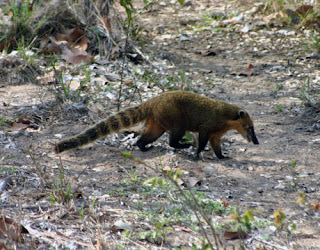SOUTH AMERICAN COATI, CROCODILE PARK, MELAKA 马六甲
The South American Coati, or Ring-tailed Coati (Nasua nasua), is a species of coati from South America. It is also found in Argentina, Bolivia, Columbia, Ecuador, Guyana, Paraguay, Peru, Surinam, Uruguay and Venezuela.
The South Amecian Coati is a diurnal animal and they live on the ground and on the trees. They typically live in the forest. They are omnivorous and primarily eat fruits, invertebrates, other small animals and birds' eggs. Coatis search for fruits in trees high in the canopy, and used their snouts to poke through crevices to find animal prey on the ground. They also search for animal prey by turning over rocks on the ground or ripping logs with their claws. Females generally live in large groups called bands which consists of 15 to 30 in numbers. Males, on the other hand, are usually solitary. Solitary males were originally considered a separate species due to the different social habits and were called "coatimundis" a term still sometimes used today. Neither bands of females or solitary males defend a unique territory, and territories therefore ovelap.
Group members produces soft whining sounds, but their alarm calls are different, consisting of lot woofs and clicks. When an alarm call is sounded, the coatis typically climb trees, and then drop down to the ground and disperse. Coati typically sleep on the branches of trees. Predators of the South American Coati include foxes, jaguar, jaguarundis, domestic dogs and man.
All females in a group come into heat simultaneously when fruits are in season. Female mate with multiple males. Gestation period is 77 days and they give birth to 2 - 4 young at a time which are raised in a nest on trees for 4 to 6 weeks. Females leave the group during this time. Females tend to remain with the group they were born in but males generally disperse from their mother's group after 3 years.
 |
| http://www.thedailygreen.com |
Group members produces soft whining sounds, but their alarm calls are different, consisting of lot woofs and clicks. When an alarm call is sounded, the coatis typically climb trees, and then drop down to the ground and disperse. Coati typically sleep on the branches of trees. Predators of the South American Coati include foxes, jaguar, jaguarundis, domestic dogs and man.
All females in a group come into heat simultaneously when fruits are in season. Female mate with multiple males. Gestation period is 77 days and they give birth to 2 - 4 young at a time which are raised in a nest on trees for 4 to 6 weeks. Females leave the group during this time. Females tend to remain with the group they were born in but males generally disperse from their mother's group after 3 years.

Comments